In an age where readers have more choices than ever, authors need to do more than just write a great book. They must also know how to effectively harness and engage their audience. One powerful tool to do this is the Call to Action, or CTA. Which is why the Alliance of Independent Authors AskALLi team is examining what well-crafted calls to action can do.
What is a CTA, Call to Action?
A call to action (CTA) is a marketing term that refers to a prompt that encourages the audience to take a specific action. The action you want people to take could be anything: downloading a brochure, signing up to a newsletter, purchasing a product, or attending an event, among other things.
In digital marketing, a CTA often takes the form of a button or link placed in a strategic location on a webpage, in an email, or within a blog post. Its purpose is to guide users towards your intended conversion goal. The phrase used on these buttons or links usually includes a verb, such as “Buy Now”, “Subscribe”, or “Download Here”.
In the context of an author, a call to action might be found at the end of a book, blog post, or newsletter, and it could encourage readers to leave a review, share the content on social media, or buy the next book in a series.
It's worth noting that effective CTAs are clear, concise, and use compelling language that incites action. Additionally, they should stand out visually in the context of the content, so that readers' attention is drawn to them.
Everyone thinks about CTAs in terms of sales and marketing, where the goal is to move the reader to buy but CTAs are also used to encourage readers to leave a review, to ask them to share the book on social media, to subscribe to a newsletter, sign up for their email list, join a Facebook group to keep up-to-date with new releases and news, pick up the next book in the series.
For non-fiction authors creating interactive content, like online courses or webinars, CTAs are vital. They can encourage users to participate more actively, enhancing their learning and making the content more memorable.
An effective CTA should be clear, concise, and compelling, driving the reader towards a specific action, keeping their needs in mind, considering what kind of action would be most appealing or beneficial to them. It should not only connects with the reader but motivate them to take the desired action.
The more compelling you can make your CTA, the more likely it is that the reader will do what you want.
Professional Copywriter Megan Smyth on Calls to Action

Megan Smyth
The AskALLi team spoke to professional copywriter Megan Smyth.
Megan Smyth is a copywriter and consultant for trailblazing entrepreneurs, helping them tell their story, drive revenue, and make a positive impact. Find out more on her website and Instagram.
Why do indies need to be using CTAs? What are the benefits?
CTAs are what close the deal and get readers to buy your book. Without a direct CTA, someone may read the summary, add it to their TBR list, and forget about it entirely. A great CTA inspires action (and sales).
What are the top mistakes authors make with CTAs?
Not considering the reader. Instead of thinking about your goal as the author, which might be for someone to buy your book or join your newsletter, think about what’s in it for the reader. How will buying this book or subscribing to your email list benefit them?
What are some great phrases or words authors should be using in their CTAs?
It sounds simple, but just adding the word “now” to your CTA has been proven to increase conversions. Other words like “save” and “free” (as in a free sample) are also effective. Choose strong, enticing words that evoke a sense of curiosity in the reader.
Lastly, make sure your CTA is speaking directly to the reader with you-focused language. Swap phrases like “Buy my book” to “Get your copy now”.
What are your best tips to help writers make more of their CTAs and convert more?
If you can, try to create a sense of urgency. What’s at stake for them if they don’t buy right now? If you offer any special discounts or limited-time deals, incorporate those into your CTA.
Scarcity is another powerful sales tool. Some authors offer a limited number of signed copies or special editions, which can inspire people to buy before copies run out.
If you write non-fiction, think about the positive impact your book will have on the reader’s life. What transformation will it provide? Will it make them a better writer, parent, or entrepreneur? If you can tie your CTA to a sense of identity, that will drive people to take action.
Creative Calls to Action
Here are a few ways authors might incorporate unique CTAs:
- Interactive CTAs: Rather than just a “Buy Now” button, authors could create interactive CTAs. For example, they could create a quiz at the end of a blog post with a CTA that encourages readers to share their results on social media.
- Narrative CTAs: Authors can weave CTAs into the stories they tell. This can make the action feel more natural. For example, an author could share a personal story about how helpful newsletter updates have been for them, then encourage readers to sign up for their own newsletter.
- Involve Readers in the Process: Authors could ask readers to vote on the title or cover for an upcoming book. This gets readers engaged and invested in the process, while also serving as a CTA.
- Artistic Visual CTAs: Using unique and eye-catching graphics or illustrations for CTAs can make them stand out and draw readers in. This might involve designing a unique graphic for a newsletter sign-up or using a visually striking button for ebook downloads.
- Giving Value: Offering something valuable in exchange for the reader's action can be effective. This could be a free chapter of the next book, an exclusive short story for newsletter subscribers, or access to behind-the-scenes content in exchange for pre-ordering a book.
- Use Humor or Emotion: CTAs don't always have to be serious. Depending on the tone of your work, you could use humor or emotion in your CTAs. For example, “Save a character from despair. Buy the sequel now!”
CTAs in Books
Incorporating CTAs in a book can be a delicate balance. On the one hand, you want to guide readers towards further engagement. On the other hand, you don't want to disrupt the reading experience with overt marketing.
That's why, the most popular approaches are to incorporate CTAs at the beginning or end of a book (or both). These are natural stopping points either before a reader has begun a book or once they've already completed it. The end in particular is the most likely place for your readers to be engaged—they've just completed your book and hopefully enjoyed it, of course they want more.
Typically, readers will click the first link in the back of your ebook. Once they're taken out of the book they either won't return, or will only return to close the book. Which means you have to make a choice about what you want to get readers to do. There is no right or wrong choice. The choice is based purely on your goals.
For example, if you're early in your career or starting a new pen name, your goal may be to encourage mailing list sign ups. Therefore you put that link first. If you're further ahead or have more books published, your goal might be to encourage preorders on a second book in the series or link to another series to sell your backlist.
Don't forget, as indie authors, you can easily change your back matter by uploading a new file.
The key is to make these CTAs feel like a natural extension of the book. Instead of a sales pitch, frame it as an invitation for readers who want to explore the world of your book further or stay connected with your future works.
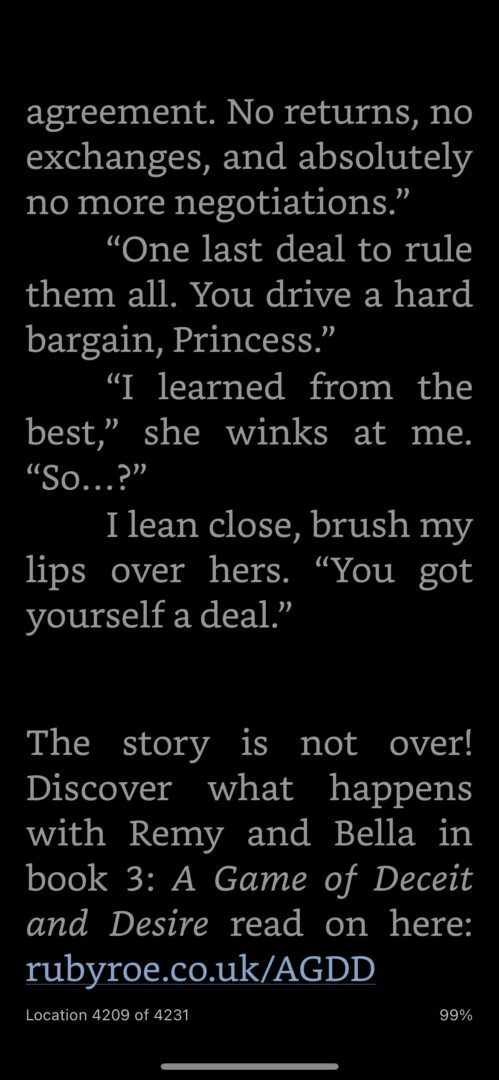
CTA in the back of Ruby Roe's second book: A Game of Romance and Ruin. Image showing an example of not using an ornamental break between the end of the story and the CTA.
CTAs in Books Tips
Amazon is extremely good at one thing: converting browsers to buyers. It does that by reducing the friction between the customer and making the sale. That's your primary goal for your CTA too.
This means that instead of putting your CTA on a new page or in an entirely new section or chapter, the most successful methods are to put them immediately after the end of your story. Many authors will use ornamental breaks, but even that can create friction if the break formats to the end of a page. If the reader knows the book is over, they may not click through. While it might feel alien to just start a new line, it does give you the highest chance of your reader seeing the CTA. See the example pictured.
Other tips include:
- If you think you might need to change the link in the back, use a redirect. That way you can change where the link points without having to update your file. For example, if you know you want to direct to a preorder, but at the time of formatting the preorder isn't live yet.
- Use a Call to Action in the front and back of your book
- Try to deliver what your readers would want most. If your aim is for sign ups, you don't have to give an entire novel away.
ALLi Blog manager Sacha Black says:
“When I released book one of my new pen name Ruby Roe, I was keen to get as many subscribers as possible, so I wrote an additional steamy scene that I knew readers would want based off of how the book ended. In the first month, I saw a phenomenal sign up rate, as high as 25% of sales converted to subscribers. Granted this has slowed now the book has been out longer and sold considerably more copies. But I'm still seeing the highest sign up rate for any of my books.”
The AskALLi Team spoke to marketing expert Nick Thacker about his unusual book CTAs:
“I’ve always been a fan of testing; I believe testing, is the real secret to long-term success. As such, I decided it would be fun (or at least a disaster that would immediately end my career) to test a call to action in the middle of my book. To be fair, it was after a chapter break, not in the middle of a chapter or a sentence!
I found that while I’m sure there were a few people who didn’t like it at all, I never heard anything from them. On the contrary, it got a decent amount of clicks , leading me to believe that had I spent some time crafting the text before the call to action to make it fit better with that particular moment in that particular book, it might actually be a decent sales/promotional tool.
For me, it didn’t perform better than a CTA at the end of the book, and putting one there has always been my preference. But the point is to test — especially those assumptions we’ve made about our businesses. Success comes from good testing over time!”
CTAs in Social Media
Social media offers a wealth of opportunities for CTAs. Every post, tweet, or update is a chance to engage with your audience and guide them towards a particular action.
On social media, the CTAs might include asking followers to share your post, comment their thoughts, or click a link to your website or book sales page. Remember that each platform has its quirks, so a CTA that works well on Twitter might not be as effective on Instagram or Facebook.
Consider the norms and conventions of each platform when crafting your CTAs. For instance, Instagram doesn't allow clickable links in post captions, so a common CTA is “Link in bio”. Twitter on the other hand, has a character limit, so you might require a more concise CTA, like “Out now – grab your copy!”.
Regardless of the platform, the key to an effective social media CTA is to make it engaging, clear, and compelling. You want your audience to feel excited about participating, not pressured into doing so. Giving the ‘why now' helps with this. For example, if the sale is time limited, say that.
CTAs for Indie Authors: Where Else Do You Use Them?
CTAs on Author Websites
An author's website serves as a hub for their online presence. It's where readers can learn more about you the author, discover your work, and stay updated on upcoming events. Which is why it's a prime location for your CTAs.
CTAs can be strategically placed throughout your website to guide visitors toward your desired locations or actions. Common examples include:
- Pop ups inviting visitors to subscribe to your newsletter
- Buttons at the bottom, in the middle or on the side of your homepage to sign up
- CTAs prompting visitors to preorder your upcoming book on your blog's sidebar or in a banner at the top of your website
Design and placement matter. CTAs should stand out on the page and be located in intuitive places. Most visitors will scan the centre of your website only and miss things on the side.
CTAs in Email Marketing
Email marketing is another powerful tool for authors, and CTAs are an integral part of any email marketing campaign. You can read our mailing list series here:
- The Ultimate Guide to Email Marketing for Authors Part 1: Mailing List Strategy
- Growing Your Reader Email List(s)
- Maintaining your Reader Email List
Whether you're sending a newsletter, a promotional offer, or an announcement about an upcoming book, your email should include a clear and compelling CTA. It might invite readers to preorder your new book, read a sample chapter on your website, share your email with friends, or even reply to your email with their thoughts.
Email allows for a more personal connection with your readers do tailor your CTAs accordingly, keeping them friendly, personal, and engaging and in line with your author voice.
Consider also how you can include subtle CTAs in your subject line, for example:
- [Time Limited]
- [Last Chance]
- Exclusive First Look At…
- Bonus Exclusive Scene
- For Your Eyes Only…
While these aren't CTAs in the most pure sense, as a CTA needs to include the action outwardly. These are subject lines with an action inherent in them. For example, time limited means buy this within X date or lose out.
The Role of CTAs in Audience Engagement
As an author, cultivating a loyal and engaged reader base is crucial. This is where CTAs can play a significant role. They are not just about getting readers to do something; they are also a valuable tool for fostering engagement and building a sense of community around your work.
CTAs can encourage readers to join a discussion, share their thoughts, or participate in a reader poll or contest. For instance, at the end of a blog post about your writing process, you might include a CTA inviting readers to comment on their favorite part of your latest book or ask them to share their own writing tips.
By actively involving your audience, these CTAs can transform your reader base from passive consumers into active participants and invested fans.
Metrics and Analytics for CTAs
So, you've created your CTAs and they are out there in the world. But how do you know if they're working? This is where metrics and analytics come in.
Different platforms offer different ways to measure the success of your CTAs. If your CTA is on a website, you might look at click-through rates or conversion rates. If it's on social media, you might measure likes, shares, comments, or link clicks. For email marketing, open rates and click-through rates can indicate how well your CTAs are performing.
Remember, CTAs are not a “set it and forget it” thing. You should monitor their performance, experiment with different approaches, and tweak your CTAs based on what the data tells you.
Examples of CTAs
The AskALLi team investigate some of the top selling authors to see what their calls to action were like. Here are some examples we think are interesting. First in is Meghan Quinn with a CTA in her book Kiss and Don’t Tell. The reason this is interesting is because Meghan uses text messaging for her marketing system which most authors don't.
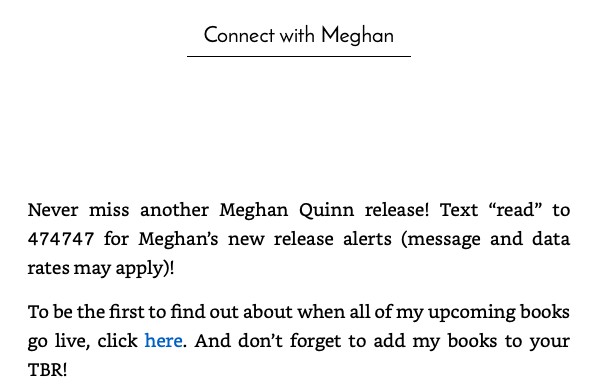
Meghan Quinn's CTA at the beginning of her book.
Next in we have a simple but effective call to action from Erin Wright and her book Arrested by Love.

CTA from Erin Wright: Arrested by Love
Next, we have an example from Elana Johnson's The Seaside Strategy.
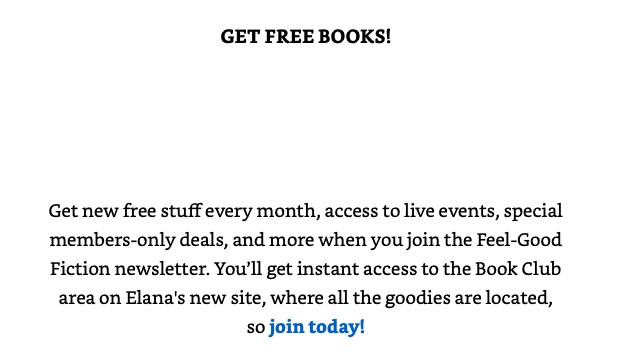
CTA from Elana Johnson: The Seaside Strategy
Finally, we have an example from Kait Nolan and her book Mixed up with a Marine.
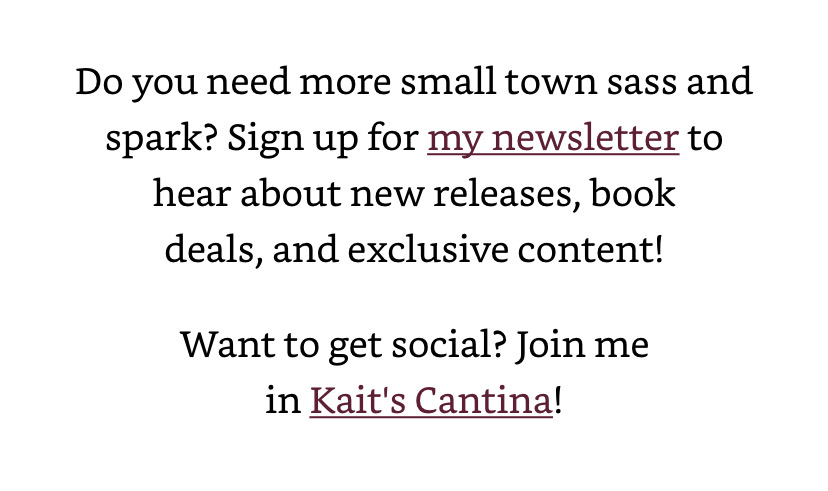
CTA from Kait Nolan: Mixed Up With A Marine




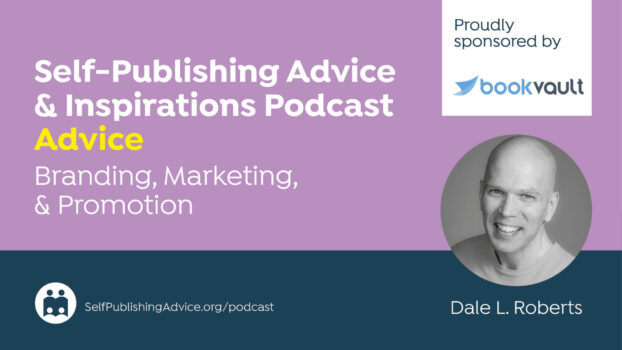
Calls to action are the secret sauce of successful book marketing for indie authors. Your blog post not only highlights their importance but also provides practical tips for crafting compelling CTAs that engage readers. Thanks for sharing these valuable insights to help authors connect with their audience and promote their work effectively!
Nice Article! In today’s saturated literary landscape, authors must not only craft exceptional books but also actively engage with readers through various mediums to stand out and foster meaningful connections.
Have seen three hundred per cent sales increase on Amazon for 2022 as against 2021. From a very low sales base. looks good in percentage terms! When I’ve secured good reviews from editors after sending a novel copy sales have increased for a while. Hoping this might happen with two latest books; one on 2022; and one after publication May.
Reality, is that POD restricts output.